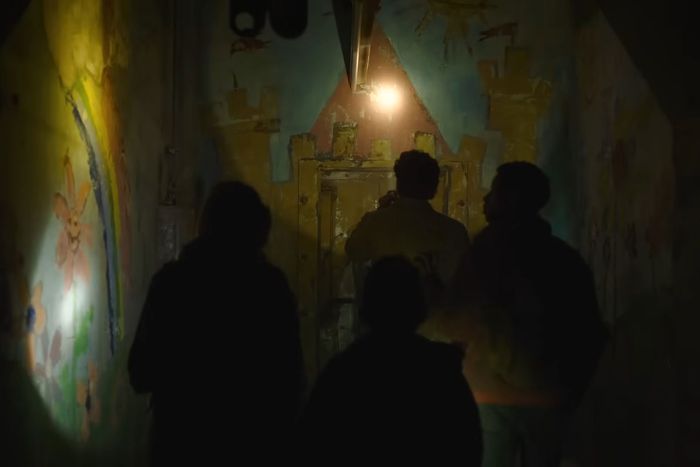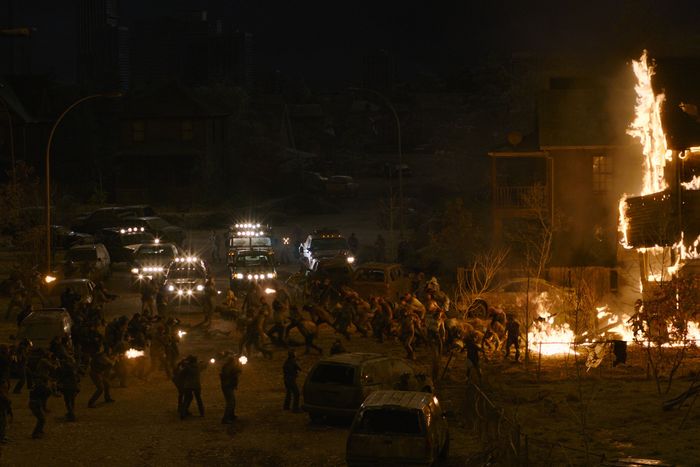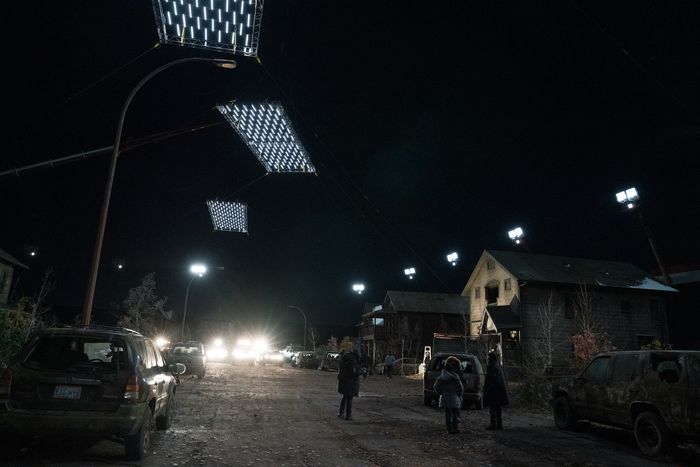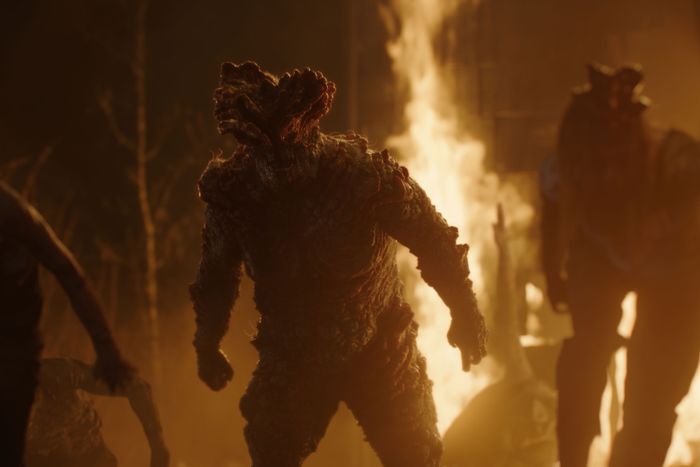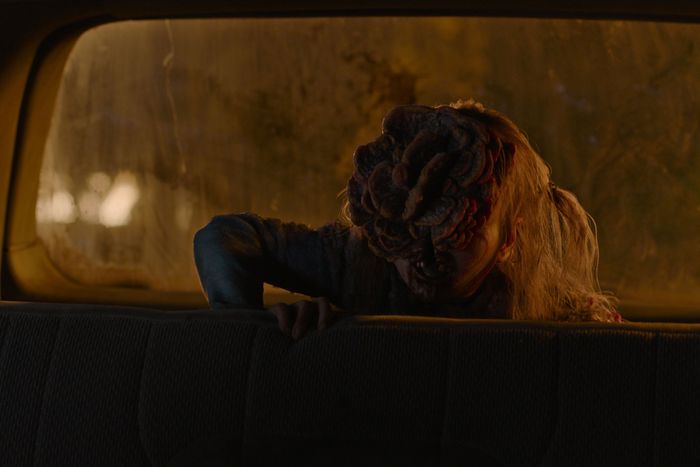
Spoilers follow for The Last of Us episode five, “Endure and Survive, which premiered on HBO Max on February 10 and airs on HBO on February 12.
“Endure and Survive” takes its name from the Savage Starlight comic that Ellie and a new friend bond over while hiding out in the Kansas City underground. After fleeing from the rebels that overthrew the city’s FEDRA authorities, Ellie and Sam (Keivonn Woodard) play together, reciting the comic’s motto, as Joel and Sam’s older brother, Henry (Lamar Johnson), recognize in each other the protectiveness they’ll need to make it out of Kansas City. But by the end of the episode, Henry and Sam are dead, Kansas City is overrun by the infected, and Joel and Ellie are alone again. For episode director Jeremy Webb, that “awful and tragic” ending — and the resilience Joel and Ellie display afterward — is the Last of Us way.
“That’s just life, and you go on,” Webb says. “Joel knows that he’s in emotional quicksand up to his neck. He cares for Ellie in the same way that he cares for the daughter he could never save, and he’s in deep.”
That revelation concludes a pair of The Last of Us episodes that built a whole new world in Kansas City, where human threats roam the streets above and the infected lurk in the tunnels and sinkholes below. Those divided realms collapse in the climactic sequence of “Endure and Survive,” which pulls elements from the video game to string together one staggering set piece after another: a sniper shootout, a truck chase and crash, an explosion and sinkhole, and hundreds of Cordyceps-controlled bodies swarming out of the ground. The 12 minutes of screen time required months of preparation, four weeks of night shoots in Calgary’s tempestuous weather, and 16 VFX teams doing digital postproduction work to escalate the grotesquery of the episode’s infected villains — including the video-game favorite Bloater and the new-to-the-series child clicker. The technical challenge pays off, resulting in a thrillingly chaotic midpoint for the season that was inspired by Saving Private Ryan, Jurassic Park, and Alien and emphasizes a recurring reality of The Last of Us: Nowhere is safe.
An underground oasis.
In the fourth episode, “Please Hold to My Hand,” Joel and Ellie are waylaid in Kansas City, a change from the video game’s location of Pittsburgh. Rebels have taken over, led by the pitiless Kathleen (Melanie Lynskey) and her second-in-command, Perry (Jeffrey Pierce), who are so intent on finding FEDRA collaborator Henry that they choose to ignore a sunken cement basement roiling with unseen infected people. “Endure and Survive” begins with Henry and Sam teaming up with Joel and Ellie — who unknowingly killed some of Kathleen’s followers — to get out of Kansas City alive, a plan that requires they traverse the city via tunnels that Henry is certain (pretty certain) have been cleared of the infected.
Although tunnels appear in the Last of Us game and its sequel, they’re dotted with threats, making this an opportunity for the TV series to subvert expectations. Instead of danger, Kansas City’s subsurface provides a brief respite for the foursome in the form of a once-lively underground classroom with hopeful, verdant murals and children’s drawings decorating the walls and toys, art supplies, and comics littered throughout. “We don’t have anything in our show that doesn’t get aged and distressed and banged up and rusted,” production designer John Paino says, but in this case, bright colors had to shine through the grime.
The classroom and surrounding tunnels were created underneath an old brewery in Calgary, which had “a kind of dankness” that the production-design team fell in love with, Paino explains. The cellar was mapped with a laser-scanning program that would help the VFX team extend hallways and underwent various designs for the murals and set decoration. For Sam and Ellie, the primary-colored furniture, bags of rainbow crayons, and bins of kaleidoscopic balls and puzzle pieces are an oasis, so illuminating the space was imperative and a “fun challenge” for Paino. He built ventilation ducts that would let in water and pools of light, and Ellie and Sam take advantage of that sunlight as they play a makeshift soccer game underground — an activity they could never do outside.
When Joel, Ellie, Henry, and Sam emerge from the tunnels into a residential neighborhood close to a bridge out of town, Henry’s self-congratulation over guiding their group to the surface doesn’t last long. Their leisurely walk-and-talk amid abandoned houses and cars is interrupted by sniper fire from a shooter affiliated with Kathleen, kicking off what Webb describes as an “extraordinary dance of death.”
“This is a bad place to go.”
The cul-de-sac scene’s many moving pieces, including the rebels’ truck with an attached snowplow with “Run” spray-painted on it and the infected horde that impedes Kathleen’s quest for revenge, were extensively planned by Webb, Paino, director of photography Eben Bolter, VFX supervisor Alex Wang, and prosthetics designer Barrie Gower. (“It feels like the prep for episode five was about 80 percent that sequence and 20 percent for everything else,” Bolter says.) They storyboarded the entire scene, cycled through concept art, put together a previsualization to map the camera angles and VFX requirements, and built a six-by-four-foot scale model with miniature cars and houses to determine exactly where everyone and everything should be. “When we would have meetings with stunts, effects, safety, grip, electrical — we’re all like mad world conquerors around this big model. We were like Napoleon,” Paino says.
“Endure and Survive” was scheduled to be filmed in April 2022, right before the finale episode wrapped production. After a month of designing the cul-de-sac, Paino and hundreds of carpenters and grips started building on an acre-sized backlot adjacent to the series’s soundstages at the Calgary Film Centre. The nine-week process involved paving over gravel and putting in asphalt driveways; constructing the fronts and sides of 13 houses and distressing them with enough flooding, fallen tree branches, and burn damage to convey 20 years of neglect; arranging broken-down cars, removing their fuel tanks and engines, and coating them with chalk dust; and adding in details like crumpled birdbaths and rusted playground equipment. The sniper house was modeled after the iconic Bates residence in Psycho and Edward Hopper’s House by the Railroad, Paino says, and was aged on the inside for two weeks with water. “They’re almost like leaves and claws to grab you,” Paino explains of the curled wallpaper.
All of that dilapidation complements the cul-de-sac’s foreboding atmosphere and to make clear that, as Paino puts it, “that’s a bad place to go, and people avoid it.”
As the cul-de-sac sequence progresses, we receive horrifying answers to the questions of what’s beneath the churning storage-room floor and the whereabouts of the infected who FEDRA purged from Kansas City’s tunnels. After Joel takes out the sniper, he’s separated from Ellie, Henry, and Sam, stationed at an elevated position inside the house when Kathleen, Perry, and the rebels roll up with their “Run” truck. While accelerating toward the trio, the truck smashes into the front of one of the neighborhood’s other houses, catches fire, and sinks into a pit not unlike the one Kathleen previously shrugged off, letting loose hundreds of the infected, who sprint out, attacking each human in their way.
“We were very aware of the subterranean world being really important, and ultimately it’s Kathleen’s fault that she didn’t look after the underground,” says Webb, who directed both episodes four and five. “She gets severely punished for it.”
“How many people can we fit in that hole, and how quickly can they get out?”
The cul-de-sac scene took four weeks of night shoots with a week and a half dedicated specifically to the infected horde rising out of the ground. (While Webb jokes, “We got Calgary’d,” about the nights they lost to snow and ice, Paino was grateful for more water damage to the houses.) “Saving Private Ryan was one of our references,” Webb says. “We’re either in among it, or with Joel looking down from his turret, or fighting through the mess with Ellie. Those were the perspectives that we really wanted to hold on to photographically.”
Night-set action scenes are notoriously difficult to translate onscreen: too bright and they look overexposed or fake; too dark and you spark endless “Wait, what happened?” discourse. To ensure the cul-de-sac sequence maintained the series’s naturalistic ethos but was cogent enough to follow, Bolter needed to design lighting that could function both as moonlight and firelight, evoking what he describes as the scene’s “intrigue and horror.” The production turned off street lights two blocks away to ensure a blank slate, and Bolter took inspiration from sports stadiums, encircling the set with backlighting and illuminating it from above with ambient light. Underneath what Bolter describes as a “net” of lighting, three handheld cameras tracked the action (“We’re on incredibly long lenses to compress the space, to make it feel scary and cinematic and real,” Bolter explains), while a fourth stationary camera outfitted with a sniper-scope lens stayed in the house with Joel. All the cameras were used to capture clean plates for Wang’s digital creations; compared with the season average of 250 VFX shots, Wang says, this episode had 350 to 400, including the truck sinking into the pit and the shootout’s gunfire.
Numerous rehearsals were essential, as was splitting the sequence into pre- and postcrash segments. The team rolled with problems as they arose, including a delay caused by an issue with the snowplow on the “Run” truck, which had to start its path outside the backlot in order to work up the speed to actually smash cars out of the way. Certain elements could be filmed only once, such as the truck crashing into the house, the house’s veranda collapsing, and the ensuing explosion. Once those were captured, the truck was removed and the pit in front of the house excavated.
“Conceptually, Craig thought it went down and down and down and down. It’s just gone, and it’s all hollow down there,” Bolter says, referring to Last of Us showrunner Craig Mazin, though in reality the the pit was 12 to 15 feet and fitted with stairs. Ten to 15 stunt actors in Clicker masks and 60 extras in infected makeup packed into the ditch prepared to launch into the unsettling physicality that movement choreographer Terry Notary, known for the Planet of the Apes trilogy, had coached them through in boot camp. After streaming out of the pit, the stunt actors and extras engaged in the “little death scenarios” they had practiced, Webb says, with the infected leaping over cars, lunging toward any body parts they could reach, and teaming up to restrain and bite the rebels.
“All the conversations were ‘How many people can we fit in that hole, and how quickly can they get out?’ ‘How insane can we make that first reveal?’” Bolter explains. That discussion was especially fervent when it came to a major baddie from the game who receives his TV-series debut in this scene.
Release the Bloater.
“How much are we hiding, or how much are we showing? What’s scarier?” Bolter says of their approach to unleashing the most advanced stage of Cordyceps infection yet seen in the series. For Webb, the grandeur of the cul-de-sac scene made it perfect for the Bloater reveal — and as much visibility as possible. “When you have a sinkhole, which is on fire in a cul-de-sac, and a whole bunch of revolutionaries who are keen to get Joel and Ellie, it’s time to release the Bloater,” he says. The reveal of the hulking, growth-covered creature who surges out of the pit, towers over humans, and easily dismembers them was shaped by the elusiveness of Alien’s extraterrestrial threat and the directness of the dinosaurs in Jurassic Park.
Along with the Bloater, who serves as the de-facto leader of the horde, certain infected people stand out from the rest. The two clickers who chase after Ellie and the separate pair who try to pull Henry and Sam out from under a pickup truck are played by returning actors Olivier Ross-Parent and Samuel Hoeksema, who were the museum clickers in the second episode, “Infected.” And while those adult clickers can’t fit into the van where Ellie is hiding, a smaller villain can: a child clicker, an invention for the series meant to signify the undiscerning cruelty of Cordyceps. Both the Bloater and the child clicker were first practically crafted by Gower and his wife and creative partner, Sarah Gower, then re-created for maximum ferocity and inhumanity by Wang’s VFX team.
The Gowers spent five months testing looks for the infected and the clickers, differentiating them based on their environments and levels of infection: desaturated crispiness for dry locales, flourishing greens for moist ones. “We’ve got folders and folders and folders of so many different fungi and mushrooms and slime molds, all kinds of weird and wonderful things,” Gower says. That research helped them tackle episode five, which they knew would be “the beast” with “an army of performers in lots of prosthetics.” They decided upon looks with red and green fungi, dirt and sludge, and “quite a lot of moisture and gloss” to help the prosthetics shine under the scene’s moonlight and firelight. After the Gowers arrived in Calgary with a dozen or so members of their U.K. team and a few American friends, they put out a call for locals, eventually bringing on 60 to 70 additional prosthetic-makeup artists. For the cul-de-sac scene, the artists paired off for three-hour shifts, applying prosthetics to 30 people at a time to get them ready for rehearsal and filming.
The horde is an amorphous mass, its horror coming from the seemingly endless churn of bodies arising from the pit. The Bloater and the child clicker, meanwhile, make an impact through their otherness — their respective gigantism and diminutiveness compared with the rest of the infected. Given their prominence, the Bloater and the child clicker necessitated considerable collaboration between the prosthetics and VFX teams. For filming, the Bloater was played by actor Adam Basil, whom Gower recommended after working with him on Game of Thrones. Basil was outfitted with a multipiece full-body suit of sculpted foam rubber, an image that Wang “could not stop staring at” because of its resemblance to the video-game character.
“The idea was to have this practical presence on set that could interact with the actors and give a performance that VFX would then be able to augment in postproduction,” Gower explains. Basil’s performance and inch-by-inch scans of Gower’s suit were the VFX starting point, and the Bloater was then made taller, given more muscle definition, and smoothed out in terms of his physical movements. (Including his decapitation of Perry: “You can’t do it practically,” Wang says with a laugh.)
The child clicker was a similarly synergetic effort between the shapes, textures, and colors of the prosthetics and the figurative and literal mushrooming of VFX. Actress and gymnast Skye Belle Cowton was cast as the twirling and whirling creature who follows Ellie into a van through a small window gap, an idea of Mazin’s that Webb describes as “wonderfully disturbing” and “delicious.” (Could this infected horde be where the missing children from that underground school ended up? Webb says that connection wasn’t explicit in the script, but he likes the idea.) After Cowton performed all those flips and twists while wearing her child-clicker mask, the footage was handed over to Wang, who consulted with Mazin and Druckmann on how to encourage empathy toward the digital double. More of her facial skin was revealed to show her youth, and messy pigtails were added to crystallize the character as a “cute child that this horrific thing happened to,” Wang says.
In addition to the Bloater and the child clicker, the VFX team digitally added 50 to 70 infected people to the horde, increasing their speed and amping up their jarring movements so they feel inhuman. “They don’t know pain. They don’t think twice before running into a car or jumping on top of somebody,” Wang explains. “Those are the type of characteristics that sometimes you just can’t get even with the best stunt team.”
Forty-eight minutes into the episode, the work of all the craft teams melds into one jarring and unnerving final cul-de-sac shot. The Bloater has torn Perry apart, and the child clicker rips Kathleen to shreds in front of Joel, Ellie, Henry, and Sam. Although the four escape, they leave Kansas City in shambles. As the camera tilts upward, we see the fire spreading from the destroyed house, the Bloater bellowing, the clickers attacking the remaining rebels, and more infected racing from the pit and out of the neighborhood. The underground is no more in “Endure and Survive,” and Kansas City soon might not be, either, but all Joel and Ellie can do is leave it behind. In The Last of Us, that’s just life, and you go on.



